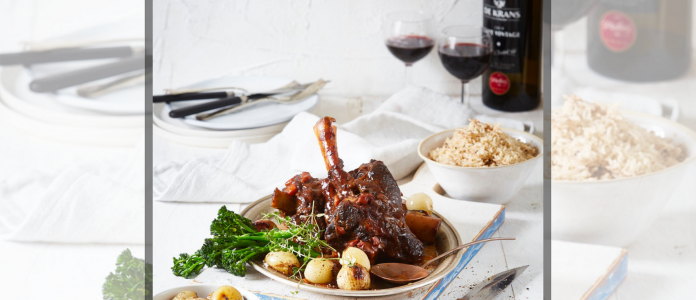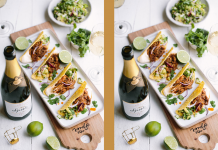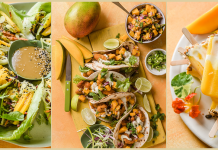Enjoy this hearty lamb shank dish, served with port roasted baby onions, pan-fried long stem broccoli, and a glass of De Krans Vintage Port.
Winter is a magical time for enjoying food and wine with friends and family – whether it is home-cooking port braised lamb shanks using the De Krans Cape Ruby (see recipe below), enjoying a glass of Cape Tawny after a lazy Sunday lunch in the winter sun, or snuggling up on the couch in front of the fireplace with a glass of Cape Vintage.
Embracing the rich heritage of South African port-style wines
When it was decided that the South African Wine industry can no longer use the word “port” on their labels back in 2011 (similar to not using Champagne, but MCC, because it isn’t made in the Champagne region in France), it was decided by the Cape Port Producers Association (CAPPA) that the word “Cape” will be used, together with the specific style, like Cape Tawny, Cape Ruby, etc.
An easy solution, it was initially thought, but it has come as no surprise that the local consumer (with the slight exception of the seasoned, sophisticated wine fundi), isn’t commonly aware of this change and as a result, that a Cape Ruby, is in fact, a Ruby port-style wine (how we refer to “port” in written media). Perhaps somewhat confusing, but if it walks like a duck, and talks like a duck, right?
Of course, produced worlds apart, and with the ports produced in Portugal leaning towards a slightly drier style, the same grape varieties are used, the same techniques implemented, and no doubt the same passion that filters through into the product.
Naturally, there is something to be said about enjoying a cold glass of white port with a Duoro Valley sunset as a backdrop or visiting one of the Cinta’s for a glass of aged Vintage.
But if there’s anything that we have learned from the Portuguese it is that port-style wine should be enjoyed, embraced, and celebrated by all, regardless of the occasion.
Traditional port-styles
With winter in full swing, it is time to talk traditional port-styles so you can find your favourite port-style wine and discover your favourite way to drink it!
De Krans Premium Cape Ruby
The De Krans Premium Cape Ruby, named after its brilliant, vibrant Ruby colour, is a non-vintage port-style wine, indicating a blend of different vintages to produce a well-rounded wine.
The wine is smooth and has velvety tannins to compliment the ripe plum, blue and red berries with a touch of cinnamon, spice, and violets, making it the perfect port-style wine to use for cooking (or baking). Go ahead and add the De Krans Premium Cape Ruby generously to your potjie or any meat dish in a slow cooker – guaranteed to take your meat dish to that next level.
The Cape Ruby also pairs well with traditional Cape bobotie, waterblommetjie–bredie, rustic pasta, and hearty soups.
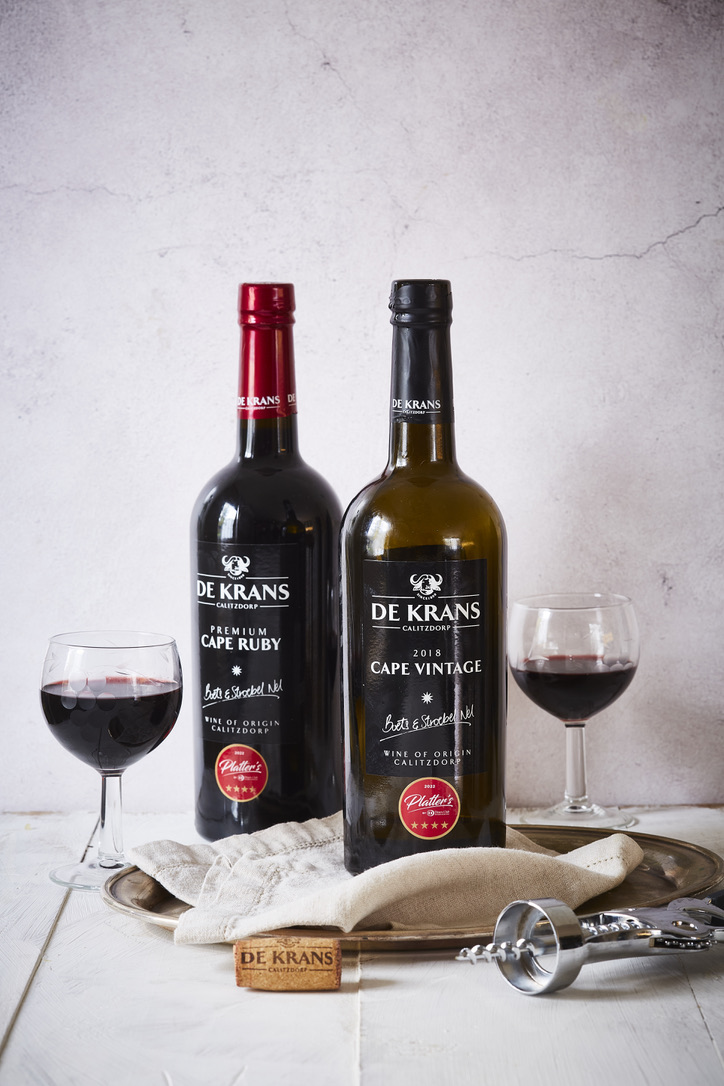
De Krans Cape Vintage
If you are looking to enjoy your port-style wine either on its own or paired with a yummy dessert, you definitely can’t go wrong with the De Krans Cape Vintage, which pairs beautifully with a baked dessert like chocolate fondant, a piece of dark chocolate, or well-matured cheese.
Vintage ports also pair well with Karoo lamb potjie, venison pie, or roasted vegetable lasagna. This port-style wine has a deep purple-red colour, indicative of its intense, full, and rich palate of red fruits, dried prunes, cocoa, and spice.
Tannins are more prominent in this port and this style is made to bottle age (up to 20 years) or can be enjoyed at an early age as well. This port-style wine is an excellent, value-for-money, and quality port-style wine.
De Krans Cape Tawny Limited Release
Of all the different port-style wines, the De Krans Cape Tawny Limited Release is probably the most unique and different from the other port-style wines. It is named after its amber/tawny color, a color acquired by spending an average of eight years ageing in an oak barrel. Due to this ageing and slow oxidation, tannins are soft and fruity flavours that have developed into nutty, toffee, and caramel flavours.
De Krans Cape Tawny Limited Release is an excellent alternative to sherry and is best enjoyed slightly chilled. The Cape Tawny not only pairs well with baked winter puddings like malva pudding, and crème brûlée, as well as baked cheese with drizzled honey, nuts, and rosemary, but will also elevate dishes like brown onion soup, loin of pork stuffed with dried fruit, or prawns prepared in a light Malaysian style.
De Krans Cape Vintage Reserve
The De Krans Cape Vintage Reserve, the flagship at De Krans, is truly something special. This port has a very aromatic nose of ripe red berries and cherry, stewed prunes, and dark chocolate, and is a dark black colour with a plum red rim. This port-style wine from De Krans has won numerous Platter 5-star ratings, Veritas Double Gold medals, and various other accolades in the past 2 decades, including being named the best-fortified wine in the South African Wine Report, by British Wine Master Tim Atkin.
To truly experience and appreciate the quality of this exceptional wine, the Cape Vintage Reserve is best enjoyed on its own. Alternatively, it pairs well with matured cheese. In addition, the Cape Vintage Reserve also makes an excellent gift, seeing as it can be stored and matured for up to 40 years (in favourable cool conditions, with the bottles lying down).
Available directly off the farm, or at select outlets nationwide these premium port-style wines retail for R107 (Cape Ruby), R139 (Cape Vintage) and R240 (Cape Tawny), respectively. For more information visit www.dekrans.co.za.
Port braised lamb shanks
(Serves 4)
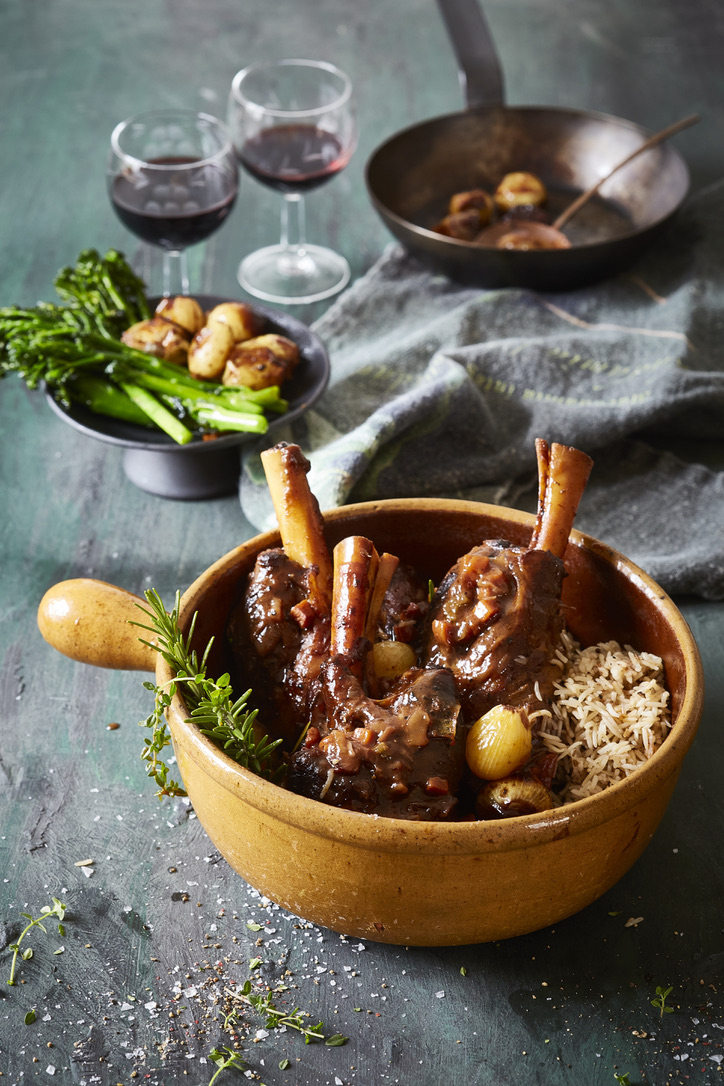
Ingredients
- 4 lamb shanks
- Salt and pepper for seasoning
- 15 ml barbeque seasoning
- 30 ml olive oil
- 4 garlic cloves
- 1 large onion, chopped
- 1 carrot, diced
- 2 celery sticks, chopped
- 30 ml flour
- 60 ml tomato paste
- 375 ml DE KRANS RUBY PORT
- 375 ml chicken or lamb stock
- 2 Rosemary sprigs
- 4 Bay leaves
- Fresh thyme sprigs
Method
- Season the lamb shanks well and heat half of the olive oil in a large saucepan. Brown the meat well on all sides and remove from the saucepan.
- Add the rest of the olive oil to the saucepan and then add the garlic, onion, carrot and the celery.
- Cook for a few minutes until it starts to soften – stir regularly
- Add the flour to the onions and stir to mix, then add the PORT and the stock. Mix well to prevent lumps from forming.
- Add the tomato paste and the herbs.
- Return the meat to the saucepan, turn the heat to low and place the lid on the saucepan. Simmer for about 2 hours 30 minutes until the meat if soft and almost falling off the bone.
- Check regularly to see if you need to add extra liquid and seasoning.
- Serve with rice, couscous, polenta, or potato mash accompanied with port roasted baby onions and pan-fried long stem broccoli.
- Garnish with fresh rosemary and thyme.
Port roasted baby onions
- Place 1 kg peeled baby onions in a roasting dish, season with salt and pepper and 10 ml sugar.
- Drizzle over 30 ml olive oil and 80 ml DE KRANS RUBY PORT.
- Roast in the oven on 180°C for about 30 minutes until the onions are golden brown and cooked.
Tip: This dish is best served with De Krans Vintage Port.

